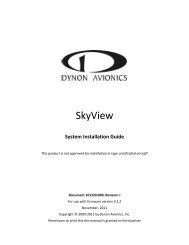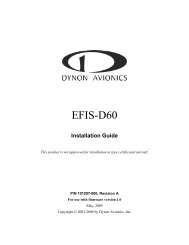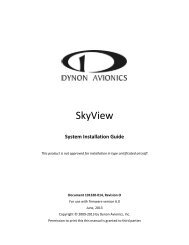EFIS-D100 Installation Guide - Dynon Avionics
EFIS-D100 Installation Guide - Dynon Avionics
EFIS-D100 Installation Guide - Dynon Avionics
Create successful ePaper yourself
Turn your PDF publications into a flip-book with our unique Google optimized e-Paper software.
Appendix<br />
Boom mount<br />
PLUMBING<br />
NOTE: Because the pitot and AOA plumbing tubes have not been annealed, they work-harden<br />
rapidly when manipulated. Make gentle bends, and only bend any given section once.<br />
After mounting the probe, route the pitot and AOA lines from the probe to your <strong>EFIS</strong>-<strong>D100</strong>. The<br />
tube closest to the snout is the pitot line, while the tube in the rear is the AOA line. There is no<br />
static source on the probe.<br />
After mounting the probe, install adapters to connect the 3/16 plumbing lines from the probe to<br />
whatever plumbing lines run back to the <strong>EFIS</strong>-<strong>D100</strong> in your aircraft (AN 919-2D for 3/16 to ¼).<br />
We strongly recommend using aircraft grade fittings such as standard AN fittings. Make sure the<br />
plumbing lines do not chafe or interfere with any aircraft control systems.<br />
PRESSURE CHECK<br />
<strong>Dynon</strong>’s pitot design deliberately has a pin-sized leak hole in each of the two tubes to permit<br />
draining any moisture which might accumulate inside. These holes are located in the middle of<br />
the tube at the bottom. Plugging these holes does not guarantee a pneumatic seal (although one is<br />
sometimes present). The leak that may exist does not affect the performance of the probe. You<br />
will, however, need to take it into account when doing pressure/leak tests on your pitot system<br />
CALIBRATION<br />
CAUTION: It is your responsibility to fly your plane safely while performing any<br />
configuration or calibration in flight. The best scenario would include a second person to<br />
perform any necessary steps on the <strong>EFIS</strong>-<strong>D100</strong>.<br />
Once you are flying straight and level at a safe altitude for stalls, enter the <strong>EFIS</strong> > SETUP ><br />
AOACAL menu. While the AOACAL menu is displayed, oscillate the aircraft between ± 5°<br />
pitch 4 times at fast cruise airspeed. During this maneuver the <strong>EFIS</strong>-<strong>D100</strong> records the lowest<br />
angle of attack that you usually see during flight. You do not need to push any additional buttons<br />
before starting this maneuver.<br />
Refer to the list below of the stalls recommended to complete the user calibration. The general<br />
idea is to record stall data to find the lowest angle of attack stall. The list we have suggested is a<br />
starting point and produces a good calibration under most circumstances. However, if there are<br />
7-30 <strong>EFIS</strong>-<strong>D100</strong> <strong>Installation</strong> <strong>Guide</strong>
















